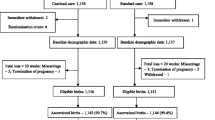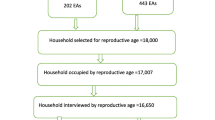Abstract
Purpose
To identify patient perspectives of barriers to cervical length screening to prevent preterm births.
Methods
In Phase I of this prospective descriptive implementation study, 40 pregnant women of up to 24 week gestation were interviewed. Phase II comprised questionnaire development and data validation. The questionnaire was subsequently administered to 400 participants in Phase III.
Results
Most participants (74.3%) realised preterm babies have complications and high care costs (53%). They recognised that premature-birth risk identification enables appropriate pregnancy care (93.8%), but they were unaware that cervical length measurements indicate the risk (59.5%). The participants who were aware wanted to be examined (63.5%) because of concern about preterm birth (95.8%). Husbands were reported to influence decision-making about screening (81.3%) and subsequent treatment (42.5%). If the associated costs were subsidised, the majority of participants (67.3%) would undergo screening.
Conclusion
Physicians do not explain ways to prevent preterm births. Government policy on preventing preterm births is not well established. Screening and treatment costs are major barriers.
Trial registration
Thai Clinical Trials Registry (TCTR) number: TCTR20190813003
Similar content being viewed by others
Change history
29 April 2021
A Correction to this paper has been published: https://doi.org/10.1007/s00404-021-06078-8
References
WHO (1977) recommended definitions, terminology and format for statistical tables related to the perinatal period and use of a new certificate for cause of perinatal deaths. Modifications recommended by FIGO as amended October 14, 1976. Acta Obstet Gynecol Scand. 56(3):247–53.
Araujo BF, Zatti H, Madi JM, Coelho MB, Olmi FB, Canabarro CT (2012) Analysis of neonatal morbidity and mortality in late-preterm newborn infants. J Pediatr (Rio J) 88(3):259–266
Kinney HC (2006) The near-term (late preterm) human brain and risk for periventricular leukomalacia: a review. Semin Perinatol 30(2):81–88
Colatat T. Situation of preterm birth: The maternal and childhealth network2005. Available from: http://www.tmchnetwork.com/node/163.
Erny R, Pigne A, Prouvost C, Gamerre M, Malet C, Serment H et al (1986) The effects of oral administration of progesterone for premature labor. Am J Obstet Gynecol 154(3):525–529
Alfirevic Z, Owen J, Carreras Moratonas E, Sharp AN, Szychowski JM, Goya M (2013) Vaginal progesterone, cerclage or cervical pessary for preventing preterm birth in asymptomatic singleton pregnant women with a history of preterm birth and a sonographic short cervix. Ultrasound Obstet Gynecol 41(2):146–151
Goldenberg RL (2002) The management of preterm labor. Obstet Gynecol 100(5 Pt 1):1020–1037
Khalifeh A, Berghella V (2016) Universal cervical length screening in singleton gestations without a previous preterm birth: ten reasons why it should be implemented. Am J Obstet Gynecol. 214(5):603e1-5
Andersen HF, Nugent CE, Wanty SD, Hayashi RH (1990) Prediction of risk for preterm delivery by ultrasonographic measurement of cervical length. Am J Obstet Gynecol 163(3):859–867
Iams JD, Goldenberg RL, Meis PJ, Mercer BM, Moawad A, Das A et al (1996) The length of the cervix and the risk of spontaneous premature delivery. National Institute of Child Health and Human Development Maternal Fetal Medicine Unit Network. N Engl J Med. 334(9):567–72
Hein M, Helmig RB, Schonheyder HC, Ganz T, Uldbjerg N (2001) An in vitro study of antibacterial properties of the cervical mucus plug in pregnancy. Am J Obstet Gynecol 185(3):586–592
Hein M, Valore EV, Helmig RB, Uldbjerg N, Ganz T (2002) Antimicrobial factors in the cervical mucus plug. Am J Obstet Gynecol 187(1):137–144
Kiefer DG, Peltier MR, Keeler SM, Rust O, Ananth CV, Vintzileos AM et al (2016) Efficacy of midtrimester short cervix interventions is conditional on intraamniotic inflammation. Am J Obstet Gynecol. 214(2):276–6
Romero R, Avila C, Santhanam U, Sehgal PB (1990) Amniotic fluid interleukin 6 in preterm labor Association with infection. J Clin Invest 85(5):1392–1400
ACOG Practice Bulletin No.142: Cerclage for the management of cervical insufficiency. Obstet Gynecol. 2014;123(2 Pt 1):372–9.
Conde-Agudelo A, Romero R (2016) Vaginal progesterone to prevent preterm birth in pregnant women with a sonographic short cervix: clinical and public health implications. Am J Obstet Gynecol 214(2):235–242
Celik E, To M, Gajewska K, Smith GC, Nicolaides KH, Fetal Medicine Foundation Second Trimester Screening G (2008) Cervical length and obstetric history predict spontaneous preterm birth: development and validation of a model to provide individualized risk assessment. Ultrasound Obstet Gynecol. 31(5):549–54
Committee on Practice Bulletins-Obstetrics TACoO, Gynecologists (2012) Practice bulletin no 130: prediction and prevention of preterm birth. Obstet Gynecol. 120(4):964–73
Berghella V, Baxter JK, Hendrix NW (2013) Cervical assessment by ultrasound for preventing preterm delivery. Cochrane Database Syst Rev 1:CD007235
Lim AC, Goossens A, Ravelli AC, Boer K, Bruinse HW, Mol BW (2010) Use of progesterone treatment for the prevention of recurrent preterm birth: identification of obstacles to change. Am J Perinatol 27(3):241–249
Feeley TH, Cooper J, Foels T, Mahoney MC (2009) Efficacy expectations for colorectal cancer screening in primary care: identifying barriers and facilitators for patients and clinicians. Health Commun 24(4):304–315
Ramos M, Esteva M, Almeda J, Cabeza E, Puente D, Saladich R et al (2010) Knowledge and attitudes of primary health care physicians and nurses with regard to population screening for colorectal cancer in Balearic Islands and Barcelona. BMC Cancer 10:500
Temming LA, Durst JK, Tuuli MG, Stout MJ, Dicke JM, Macones GA et al (2016) Universal cervical length screening: implementation and outcomes. Am J Obstet Gynecol 214(4):523–8
Pedretti MK, Kazemier BM, Dickinson JE, Mol BW (2017) Implementing universal cervical length screening in asymptomatic women with singleton pregnancies: challenges and opportunities. Aust N Z J Obstet Gynaecol 57(2):221–227
Acknowledgements
We thank the Faculty of Medicine Siriraj Hospital, Mahidol University for financially supporting the editing and providing proofreading by a native speaker. We also appreciate the administrative support provided by Nattacha Palawat.
Funding
The Faculty of Medicine Siriraj Hospital, Mahidol University, provided funding support [(IO) R016233023].
Author information
Authors and Affiliations
Contributions
SC and VT contributed to the conception and design of the research; the acquisition, analysis and interpretation of data; the drafting and critical revision of the manuscript; and the approval of the final manuscript. SA contributed to the recruitment of the patients, revision of the manuscript, and approval of the final manuscript. AK contributed to the transcription of data from the audio recordings, and approval of the final manuscript. JP contributed to the analysis and interpretation of data, critical revision of the manuscript, and approval of the final manuscript.
Corresponding author
Ethics declarations
Conflict of interest
The authors completed the International Committee of Medical Journal Editor’s Form for Uniform Disclosure of Potential Conflicts of Interest. All authors have nothing to disclose. All procedures performed in studies involving human participants were in accordance with the ethical standards of the institutional research committee (Si 480/2019), and with the 1964 Helsinki declaration and its later amendments or comparable ethical standards. Written, informed consent was obtained from the study participants.
Ethical approval
The research was approved by the Ethics Committee of the Siriraj Institutional Review Board (COA Si 343/2562).
Consent to participate
Informed, signed consent was obtained from all participants before study commencement.
Consent for publication
We agree to submit this study to Archives of Gynecology and Obstetrics for publication.
Additional information
Publisher's Note
Springer Nature remains neutral with regard to jurisdictional claims in published maps and institutional affiliations.
The original online version of this article was revised due to correction in the name of the 3rd author.
Rights and permissions
About this article
Cite this article
Chawanpaiboon, S., Titapant, V., Anuwutnavin, S. et al. Identifying the barriers to universal cervical length screening for preterm birth prevention at a tertiary hospital in Thailand (patient’s perspectives): implementation research. Arch Gynecol Obstet 304, 1179–1188 (2021). https://doi.org/10.1007/s00404-021-06045-3
Received:
Accepted:
Published:
Issue Date:
DOI: https://doi.org/10.1007/s00404-021-06045-3




